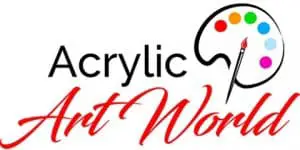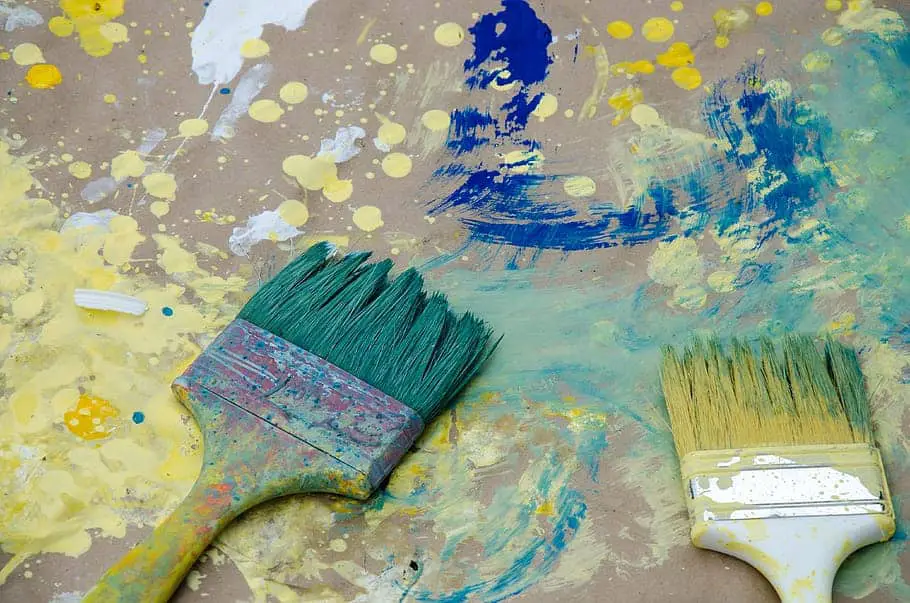In this article I will go over the characteristics and usage of two paint types: acrylic, and the lesser known gouache.
Acrylic is a popular painting medium, well loved for its versatility and, at least in the world of arts and crafts, its low cost. Gouache is often described as an opaque watercolor; it is thicker than watercolor, however, and does not allow the surface on which you’re painting to show through.
Both acrylic and gouache are water-based paints, easy to clean, and affordable.
Because acrylic paint technology has advanced so far, there does exist “acrylic gouache” just like there exists acrylic paints that mimic watercolors, oils, inks — you name it. Typically when we talk about acrylic paint, however, we are referring to the popular standard; a low cost, medium thickness paint with a plastic (“acrylic”) binding agent, which adheres the pigment to the liquid base.
More on “acrylic vs. gouache” below.
The Pros and Cons of Working with Acrylic Paints
The exploration of mediums by artists in the early-mid 20th century, especially the rejection of traditional European techniques by some of the Mexican artists in the 1930’s-50’s, such as painter and muralist David Alfaro Siqueiros (who taught and hugely influenced Jackson Pollock, among other American artists), was integral to the development of the modern and extremely versatile acrylic paints we now depend on across disciplines.
Today, acrylic paint can be specialized for any use. Acrylic gouache is an example of this specialization. In order to make the acrylic paint resemble gouache, the ratio of pigment to base is adjusted, and ingredients are added to create a matte finish. Once dry, however, the acrylic medium is no longer water-soluble–meaning you cannot re-wet and re-work the paint the way you can with gouache.
Here is a quick list of the highlights and drawbacks of using acrylic paint.
Pros of using acrylic paints
- Colors dry the same. The color you put down wet, while using acrylic paint, will be the same color you see after it has dried. This is true whether you are using standard acrylic paint or the acrylic gouache, and is famously not true for watercolor and traditional gouache paints.
- Quick drying. Acrylic paints dry quickly, which means you can more conveniently layer your colors without them blending. Because acrylic paint is no longer water-soluble when it has dried, the colors will not mix together.
Cons of using acrylic paints
- Quick drying. How quickly acrylics dry is often considered a perk, as I’ve outlined above; however, if you’re using acrylic gouache and you value the characteristics of gouache paint, you’ll likely want them to stay wet for longer. Gouache can be reanimated and re-worked by adding water, but acrylic gouache is like all acrylic paints in that once it is dry, it is locked in place.
The Pros and Cons of Working with Gouache
Gouache is sometimes called body color, opaque watercolor, or poster paint. Although the term “gouache” is French, it was adapted from the Italian “gauzzo”–meaning “mud.” It is like mud in that it is a simple mixture and dries with a matte finish. For a time it was created by mixing watercolor paints with a white pigment to make it opaque.
Gouache became a popular medium amongst cartoonists and designers. It is personally one of my favorite mediums for its re-workability (just get it wet), and its beautiful matte finish. As with any medium, of course there are drawbacks, too. Here are a few pros and cons of working with gouache.
Pros of using gouache paint
- Water-soluble. Gouache can be re-worked even after it has dried, simply by re-wetting it. Though this can take some getting used to, it is a very convenient trait and allows you to make changes as your ideas evolve.
- Options. When using gouache you have the option of tubes or pans. Gouache in tube form is already wet, though you can still add water to adjust the thickness to your own standards. Gouache in pan form is dry and you add your own water, which means you have a little more control over its consistency from the start. Acrylic gouache only comes in tube form.
Cons of using gouache paint
- Choosing a surface. Such a wet medium like gouache limits your options for materials on which to paint, but not by much, and you can get creative. Generally, the thicker and more durable the paper or board on which you are painting, the better, as thinner papers will warp and tear easily when wet. There is specialized paper for watercolor and gouache, but you can also experiment with materials to find what works best for you.
- Colors differ when dry. When gouache is wet the color looks different than it does when it is dry. This means it can be hard to know what the final product will look like, but I promise you will get to know the colors, wet and dry, over time.
When to Use Acrylics vs. Gouache
So, should you use gouache paint vs. acrylic for your project?
Acrylic paints are better for special projects, while gouache is primarily used for painting.
The versatility of acrylic paint and its ability to be specialized make it a great choice for a wide variety of uses. Acrylic paint makes the best fabric paint, in particular, because it is fairly elastic even when it’s dry — a necessary trait for such a malleable material.
Common uses for acrylic paints include:
There are several unique uses for gouache paint. Watercolor artists frequently use gouache to add highlights to their watercolor paintings; the opacity of the gouache makes a bold mark that stands out against the translucent watercolors.
Animation artists have been known to utilize the re-workability of gouache paint in their craft. It is extremely convenient to be able to simply re-wet an area of their painting to make a slight change, without redrawing the entire image

